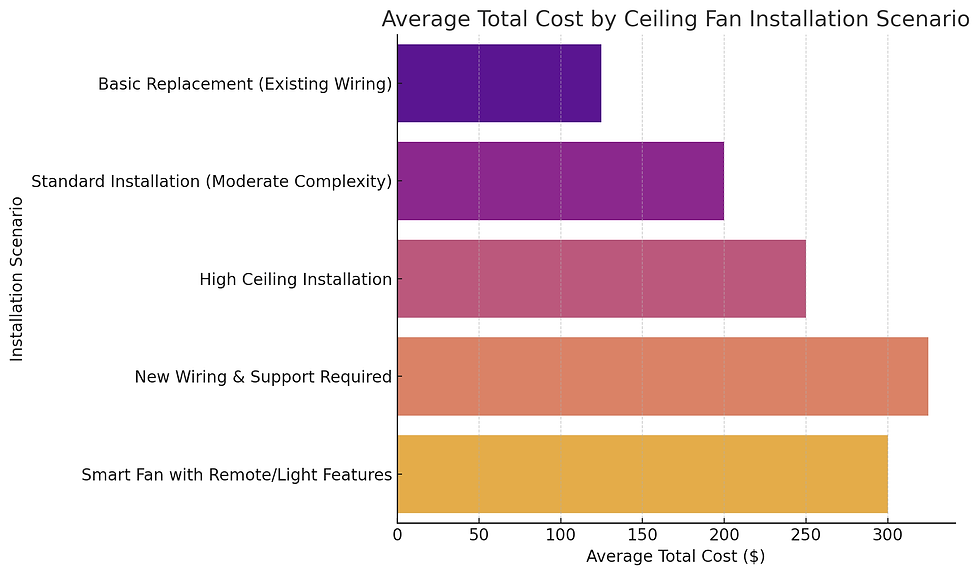How Much Does Electrician Charge to Install Ceiling Fan?
- Staff Desk
- Apr 10
- 4 min read
Updated: Jul 17
Installing a ceiling fan is a popular home improvement project that can enhance both the comfort and the aesthetics of your living space. A ceiling fan can provide a gentle breeze to cool a room in the summer and can help circulate warm air in the winter. Despite its benefits, many homeowners are often unsure about the costs associated with professional installation. In this article, we will explore the various factors that influence the cost of hiring an electrician to install a ceiling fan and provide you with insights to help you budget for this upgrade.
Factors Influencing Ceiling Fan Installation Costs

The cost of installing a ceiling fan is not determined solely by the electrician's fees. Several other factors can influence the overall expense of the project.
Complexity of Installation
The complexity of the installation plays a significant role in determining the cost. If the project involves simply replacing an old fan with a new one, the installation is likely straightforward and less expensive. However, if additional work is required, such as installing new wiring, the cost can increase substantially. Complex installations might also involve dealing with ceiling joists, adding support brackets, or integrating additional features like remote controls or smart home connectivity. Each of these elements adds layers of complexity, which can drive up the cost.
Ceiling Height and Accessibility
Ceiling height is another critical factor that can impact the cost of installation. High ceilings may necessitate the use of additional equipment, such as tall ladders or scaffolding, which can increase labor costs. The time taken to set up and safely dismantle this equipment adds to the expense. Additionally, if the fan is being installed in a hard-to-reach location, such as a vaulted ceiling or a narrow hallway, the electrician may need to employ specialized tools or techniques, further increasing the cost.
Existing Wiring and Support
The presence of existing wiring and adequate support structures can significantly reduce the installation cost. If your home is already equipped with wiring designed to handle a ceiling fan, the electrician's job becomes much simpler and quicker, reducing labor costs. Conversely, if new wiring must be run or if the ceiling must be reinforced to support the fan's weight, these additional tasks will increase the overall cost. It's advisable to have the wiring and support inspected before the installation to avoid surprises.
Type of Ceiling Fan
The type of ceiling fan you select also impacts installation costs. Basic ceiling fans without additional features are generally straightforward to install. However, if the fan includes features like integrated lighting, remote control operation, or smart home capabilities, the installation process becomes more complex. These features require additional wiring and setup time, which can increase the cost. When choosing a fan, consider how its features might affect installation complexity and cost.
Estimating the Cost of Ceiling Fan Installation

Getting a precise estimate for ceiling fan installation requires careful planning and communication with potential electricians. Here are some steps to help you get an accurate idea of what you might pay.
Get Multiple Quotes
One of the best ways to ensure you're getting a fair price is to obtain multiple quotes from different electricians. This not only helps you understand the going rate in your area but also gives you leverage in negotiating a better deal. When requesting quotes, provide as much detail as possible about the installation to receive accurate estimates. Comparing several quotes also allows you to evaluate the professionalism and responsiveness of each electrician, aiding in your final decision.
Discuss Your Needs
When speaking with electricians, clearly communicate your specific needs and any unique challenges associated with the installation. If your ceiling is particularly high or if you have specific preferences for fan features, mention these during your discussions. Providing this information upfront allows the electrician to give a more accurate estimate and reduces the likelihood of unexpected costs arising during the project.
Ask About Additional Costs
Always inquire about any potential additional costs that might arise. This includes travel fees, charges for additional materials, and any extra labor that might be required. Understanding these potential costs upfront helps prevent budget overruns and ensures there are no surprises when the final bill arrives. A reputable electrician should be transparent about potential additional costs and willing to discuss them with you.
The Importance of Hiring a Professional Electrician

While it might be tempting to tackle ceiling fan installation as a DIY project, hiring a professional electrician is often the most prudent choice for several reasons.
Safety
Working with electricity poses inherent risks, particularly for individuals without the proper training and experience. A professional electrician is well-versed in safety protocols and has the expertise to handle electrical systems safely. For instance, if you need a reliable and skilled electrician in Rocklin, choosing a certified professional ensures all work is done up to code and with the highest safety standards. By hiring a professional, you reduce the risk of accidents or injuries during the installation process, ensuring a safe outcome for both you and your home.
Efficiency
Professional electricians are equipped with the skills and tools necessary to complete the installation quickly and efficiently. They can troubleshoot potential issues on the spot and ensure that the fan is installed correctly the first time. This efficiency not only saves you time but also minimizes disruptions to your daily routine. Moreover, a professional installation ensures that the fan functions as intended, providing the desired comfort and energy savings.
Long-term Savings
Investing in a professional electrician can lead to significant long-term savings. An improperly installed ceiling fan can cause electrical problems that may require costly repairs down the line. Additionally, if the fan is not installed correctly, it may not operate efficiently, leading to higher energy bills. By ensuring the fan is installed properly from the outset, you protect your investment and avoid potential future expenses.
Average Total Cost by Ceiling Fan Installation Scenario

Conclusion
The cost of hiring an electrician to install a ceiling fan can vary widely based on several factors, including the electrician's fees, the complexity of the installation, and any additional work required. On average, you can expect to pay between $100 and $300 per fan for professional installation.
To ensure you receive the most accurate estimate, it's essential to obtain multiple quotes, discuss your specific needs with the electricians, and inquire about any additional costs. While it might be tempting to save money by attempting a DIY installation, investing in a professional electrician ensures a safe, efficient, and long-lasting ceiling fan installation, providing you with peace of mind and comfort for years to come.


Comments